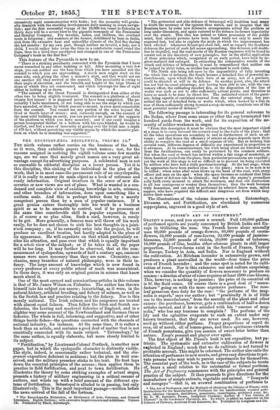PIESSE'S ART OF PERF17MERY. * GRATIFY a sense, and you secure
a reward. Full 150,000 gallons of perfumed spirits are yearly consumed by British India and Eu- rope in titillating the nose. One French house alone annually uses 80,000 pounds of orange-flowers, 60,000 pounds of cassia- flowers, 54,000 pounds of rose-leaves, 32,000 pounds of jasmine- blossoms, 32,000 pounds of violets, 20,000 pounds of tuberose; 16,000 pounds of lilac, besides other odorous plants in still larger proportion. Flower-farms exist, in the South of France Turkey in Europe, Turkey in Asia, and India. Nor is England without the cultivation. At Mitcham lavender is extensively grown, and produces a plant unrivalled in the world—four times the price even of French lavender ; and the same spot is noted for its culti- vation of roses. Nor is this extensive use and culture surprising, when we consider the quantity of flowers necessary to produce an essence a drachm of attar of roses requires at least 2000 rose-blooms. This, however, is nothing to jasmine; the price of its essential oil is 9/. the fluid ounce. Of course there is a good deal of " manu- facture " going on with the more expensive perfumes. The rose- leaf geranium does duty for the rose : "the perfume of the mag- nolia is superb," says our author; but "practically it is of little use to the manufacturer," from the scarcity of the plant and other, caused: the purchaser, however, gets a combination of half-a-dozen, articles instead, and if he is satisfied with his " essence of mag- nolia," who has any business to complain P The perfume of the lily and the eglantine evaporate to such an extent under any known treatment, that they are never used. No one, however, need go without either perfume. Proper proportions of esprit de rose, oil of neroli, oil of lemon-grass, and three spirituous extracts. of French pomatums, give you essence, of sweet-briar better than nature. Esop's peasant and player over again. The first object of Mr. Piesse's book is not expositive, but pa- triotic. The systematic and extensive cultivation of flowers is neglected in England ; much that we do cultivate is not turned to profitable account. This might be reformed. The author also calls the attention of perfumers to new scents, and gives easy directions topri- vats persons who may wish to pursue experiments for themselves; The essential part of the book, as lathe case of the subjects he treats of, bears a small relation to the substantial or formal portion's. The Art .of Perfumery commences with the principles and general' practice of the subject. It then proceeds to give threotions for the manufacture of simple extracts, vegetable and animal. "Bouquets and nosegays "—that is, an avowed combination of perfumes to
• The Art of Perfumery, and the Methods of obtaining the Odour, of Plants; with Instructions for the Manufacture of Perfumes for the handkerchtef, scented pow- ders. odorous vinegars, dentifrices, pomatums, cosmetiques, perfumed soap, &c.
By. G. Septimus Please, Analytical Chemist; Author of "The Odours of Flowers!' in the Gardeners' Chronicle, Arc. To which is added an Appendix on tho Colours of Flowers, Artificial Fruit Essences, &c. Published by Longman and Co.
produce a tertinm quid—are fully entered into. These sections exhaust the quasi-scientific part of the art; the remainder takes more the character of manufacture,—as sachets or perfume-bags, pastiks, perfumed soap, emulsions, cold cream, hair-dyes, pomades, &c. In reality, chemistry is as necessary in one branch as the other, though not appearing in so direct or delicate a way.



























 Previous page
Previous page